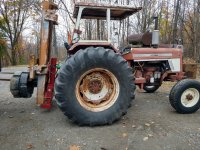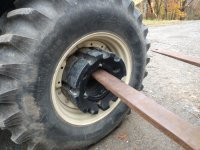ovrszd
Epic Contributor
- Joined
- May 27, 2006
- Messages
- 33,727
- Location
- Missouri
- Tractor
- Kubota M9540, Ford 3910FWD, Ford 555A, JD2210
Well, gravity only ever points straight down, so weight will point that way no matter where you put it. That will never change.
In terms of front loader counterweights and ballast, there are several factors at play, and two pivot points to be aware of.
Putting liquid in the rear tires (or using wheel weights) is a very easy way to stabilize a tractor when any implement/weight is installed forward of the front axle. Doesn't matter if it's a front loader or a snowplow or something else, when it's in the air it has leverage about the front axle and will reduce the downforce and traction of the rear wheels. If you want to counter that effect, then liquid in the rear tires is a very simple and easy solution to fix those problems. It doesn't have to be a lot of liquid, because the liquid's lever arm to the front axle is long, generally a lot longer than the lever arm of the front implement to the front axle.
The problem with the above approach is that it doesn't take weight/load off the front axle. But we're just talking about empty implements and doing it with the goal of restoring downforce and traction to the rear wheels to what they were prior to installing the front implement. And we can make a fair assumption that the tractor manufacturer has sized the front axle and wheels to carry the load of those front implements.
Counterweight *behind* the rear axle becomes important when you carry additional load in the front implement, say a load of dirt in the front bucket. It's that scenario where we now need to offset the weight and leverage of the load, and we also want to reduce load on the front axle and tires. The only way to do that is to make the rear axle become the pivot point for the levers. That is why we go with rear ballast boxes or counterweights. Their position behind the rear axle creates a moment (force x distance) that will offset the moment created by the load in the bucket.
All weights on the tractor will always act straight down, and all weights on the tractor can have leverage relative to the pivot points of the front and rear axles. This is important to visualize. Weights over axles will improve downforce and traction of the wheels on that axle but they won't generate moments about that axle. But they will generate moments about the other axle.
Very well written!!!!
If we remember nothing else out of this, be it this, the fulcrum when using a loader is NOT the rear axle. It's the front axle.
Any weight added rearward of the front axle becomes counter balance. Even the operator.
Any weight added rearward of the rear axle adds counter weight to the rear axle.
Back to the original intent and question of this thread. Rear wheel weight adds stability to the tractor. Effective stability. The weight added to the rear wheel above the axle only becomes a negative when the side slope is very severe. By that time you won't care whether the tire is 75% full or 50% full.



